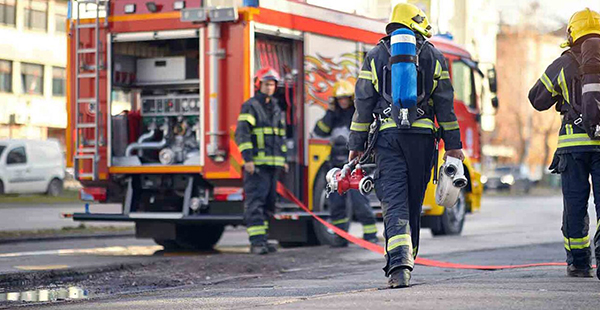How Are Firefighters Exposed to Asbestos?
Firefighters may be exposed to asbestos from burning buildings and homes. Before the 1980s, construction materials were often made with asbestos. These materials may be broken or disturbed during a fire, releasing asbestos fibers into the air.
These airborne fibers pose serious health risks to firefighters. If inhaled or ingested, asbestos fibers can cause mesothelioma, lung cancer and other asbestos-related diseases.
In 2023, occupational cancer accounted for 72% of line-of-duty firefighter deaths. This high rate makes it the top cause of this type of death.
Asbestos exposure may also occur after a fire. During cleanup efforts, broken asbestos materials and debris pose a risk to firefighters and others nearby.
Before 1970, the lasting health effects of asbestos were not well understood. The quality of personal protective equipment (PPE) reflected this lack of understanding. PPE was not made to protect against asbestos until years later.
Today, firefighters and first responders commonly wear PPE to limit exposure to dangerous materials. If equipment is removed or not properly fitted, it may be less effective at protecting against asbestos exposure.
What Asbestos Products Put Firefighters at Risk?
As part of their job responsibilities, firefighters regularly enter burning buildings and homes. If built with asbestos-containing products, these structures put firefighters at risk of asbestos exposure. When asbestos products burn, harmful fibers may be released into the air.
Firefighters may encounter the following asbestos materials in older buildings and homes:
- Adhesives
- Ceiling and floor tiles
- Cement
- Drywall
- Fireproofing
- Gaskets
- Insulation
- Joint compounds
- Popcorn ceilings
- Roof shingles
- Sealants
- Wallpaper
Asbestos-containing blankets and fireproof clothing were also a source of exposure for firefighters. Asbestos companies once made boots, gloves and protective suits for firefighting. They added the mineral to the products during the manufacturing process.
Firefighters and At-Risk Trades
Much like firefighters, similar professions are at risk of occupational asbestos exposure. Any first responder to a fire or other natural disaster may be exposed to asbestos fibers.
Other at-risk trades include:
- Detectives
- Disaster relief workers
- EMTs
- Fire inspectors
- First responders
- Forest and conservation workers
- Hazardous materials removal workers
- Paramedics
- Police officers
Family members of firefighters and first responders may also be at risk of asbestos exposure. At the scene of a fire, asbestos dust may settle in a firefighter’s hair and clothing. Loved ones may experience secondhand exposure from asbestos dust brought into the home.
Firefighter Asbestos Exposure Following 9/11
On September 11, 2001, firefighters and other first responders raced to the World Trade Center. In a rush to get to the scene, some firefighters and rescue workers weren’t wearing protective gear, including respirators.
Thousands of firefighters and first responders in New York City were exposed to airborne dust containing concrete, glass and asbestos fibers. The air remained hazardous for an unknown period after the terrorist attacks.
Both first responders and the general public received misleading or false information about its dangers. One statement from the Environmental Protection Agency (EPA) said asbestos was slightly above the normal level. But official tests had shown it at 3 times the safe limit.
Several studies after 9/11 documented a link between firefighters at the scene and increased risks of health issues, such as:
- Anxiety
- Asthma
- Cancer
- Cardiovascular disease
- Carpal tunnel syndrome
- Cerebrovascular disease
- Chronic cough syndrome
- Chronic laryngitis
- Chronic obstructive pulmonary disorder (COPD)
- Chronic respiratory disorders
- Chronic rhinosinusitis
- Cirrhosis
- Depression
- Gastroesophageal reflux disorder (GERD)
- Hearing loss
- Ischemic heart disease (IHD)
- Musculoskeletal disorders
- Panic disorder
- Post-traumatic stress disorder (PTSD)
- Sleep apnea
- Substance use disorder
Mesothelioma has a long latency period. This means it can take 10 – 50 years to develop after asbestos exposure. Other 9/11 illnesses may also take years to surface. So firefighters and other first responders may continue reporting new cases for decades.
Resources for Mesothelioma Patients
Mesothelioma Risk for Firefighters
Firefighters are at higher risk of developing certain cancers, including mesothelioma. High cancer rates may stem from occupational exposure to asbestos and other harmful materials.
The National Institute for Occupational Safety and Health (NIOSH) studied approximately 30,000 firefighters from Chicago, Philadelphia and San Francisco. Researchers found that cancer risk was much higher for these firefighters than for the general population.
In another study, firefighters had twice the risk of developing mesothelioma compared to the general population. Some evidence also suggests the risk of lung cancer increases with the time spent actively fighting fires.
Routine cancer screenings may help doctors diagnose asbestos-related diseases earlier. In general, pleural mesothelioma patients diagnosed in stage 1 and stage 2 have more available treatment options. With more choices, patients often experience a more favorable prognosis.
Compensation for Firefighters With Occupational Asbestos Exposure
Firefighters with occupational asbestos exposure who develop mesothelioma may pursue compensation through a workers’ compensation claim, asbestos lawsuit or other actions. Successful lawsuits can result in compensation from asbestos companies responsible for exposure.
In July 2007, more than 50 firefighters in Everett, Washington, were exposed to asbestos during a training session. They were not equipped with adequate PPE. Dozens of them filed a lawsuit seeking $9 million from the city. The group of firefighters agreed to a settlement requiring the city to pay for their lifetime medical monitoring.
Compensation for 9/11 Firefighters
Congress established the September 11th Victim Compensation Fund (VCF). The fund was created to compensate 9/11 firefighters and other first responders for injuries on the job. The original VCF fund was established in 2001 and closed in 2004. The Zadroga Act reopened the fund in 2011.
In 2019, the VCF was again reauthorized with $10.2 billion for claims through 2090. Victims of 9/11 asbestos exposure may still file a mesothelioma claim and receive a payout from the fund. Family members of deceased victims are also permitted to submit a claim.
Asbestos Safety for Firefighters
Firefighters face a high risk of occupational cancer, including mesothelioma. They can take actions to help limit exposure to hazardous materials, like asbestos.
Wear Respiratory Protection During Operations
When worn and maintained properly, respiratory protection equipment protects firefighters from airborne contaminants. Safety precautions created by the International Fire Service Training Association (IFSTA) state the importance of being certified to wear self-contained breathing apparatuses (SCBAs). In smoke-filled areas and other spaces with toxic dust and chemicals, SCBAs help firefighters do their job safely.
Adhere to Safety Regulations and Training
Fire departments must follow the codes and standards set by the National Fire Protection Association (NFPA). These regulations include standards for air quality, PPE and protective ensembles. Following the NFPA requirements closely may help firefighters avoid unnecessary exposure.
Some states are also passing laws to protect firefighters. In 2020, Florida signed a bill for The Firefighter Cancer Decontamination Equipment Grant Program. The program provides annual funds for training, equipment and supplies to help reduce occupational exposure.
For states without a similar program, firefighters can speak to their departments about additional training opportunities. There may be conferences, online programs and other training options available, such as through the International Association of Fire Fighters (IAFF).
Decontaminate Gear After a Fire
PPE is a firefighter’s primary line of defense against injury and illness while on the job. Experts recommend firefighters decontaminate and maintain their PPE after any firefighting operations. This includes recordkeeping, routine inspections, preliminary exposure reduction, advanced cleaning and more.
If protective gear isn’t properly maintained, it can put firefighters at risk of injuries or illnesses. Poorly maintained PPE may also expose wearers to bodily fluids, hydrocarbons and toxins.
Experts also suggest firefighters:
- Keep any potentially contaminated gear and clothing away from their homes and vehicles.
- Shower and put on clean, uncontaminated clothing before leaving the station.
These steps may help limit secondary asbestos exposure among family members and loved ones.









